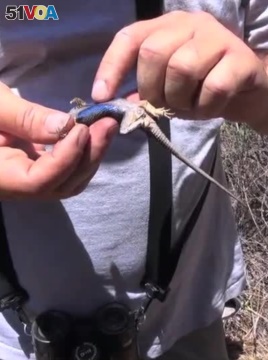August 14,2014
MURRIETA, CALIFORNIA— Teenagers have been removing invasive plants and protecting endangered species around the United States this summer, in a program run by The Nature Conservancy - a non-profit environmental group.
These girls are getting their first close-up look at lizards, doing a count of the creatures for an environmental census. Some of these species are threatened by their changing habitat.
17 years old Yulissa Arevalo is learning a lot.

“I used to just go on hikes and look at lizards and think that they were all the same, but there are different ones - horned lizards, whiptail lizards, fence lizards," she said.
The Western Fence Lizard is identified by its blue belly.
The students are part of a summer program at nature preserves and parks around the United States to educate students about the environment, and steer some into environmental careers. Open to boys and girls, it's called Leaders in Environmental Action for the Future.
Outside the Nature Conservancy's New York office, Brigitte Griswold says it's the result of a partnership between the conservation group and 25 environmental high schools.
“Students are involved in our nature preserves doing everything from shellfish restoration to restoring the L.A. River to helping to ensure healthy populations of trees right here in New York City," said Griswold.
It's a month of exploration for these California students. Some are now thinking about careers as environmental lawyers, teachers or scientists.
Griswold says whatever their chosen field, the summer program broadens their perspective.
“As we explore urban sustainability, urban planning, green infrastructure. These are all things that in order for cities to be sustainable in the future, we're going to need professionals that are really equipped to understand these issues," she said.
Julie Anaya, one of the students taking part in the summer program, plans to become a doctor and says this environmental work has opened her eyes to the effects of pollution and climate change.
“And it makes you want to do more to help the environment, because at home, you're just like, OK, [environmental degradation] is happening and I don't really care, but when you see it happening, you become more like, 'this is wrong. I have to do something about it,'" she said.
The students spend their days with biologists and older mentors. Counselor Petey Camarillo says they are working as a team, away from the usual distractions.
“Most of them are away from home for the very first time. This is a month-long program, so for four weeks, they're out here. They don't have technology - no cell phones, no television," said Camarillo.
Student Michelle Cornejo says they are learning important lessons.
“How everything is connected, from us humans to plants to mountain lions. It's pretty amazing," she said.
Mysterious holes in a nearby tree are the work of woodpeckers, and a tarantula's remains offer another teaching moment.
It's all part of the daily discovery of this summer program.